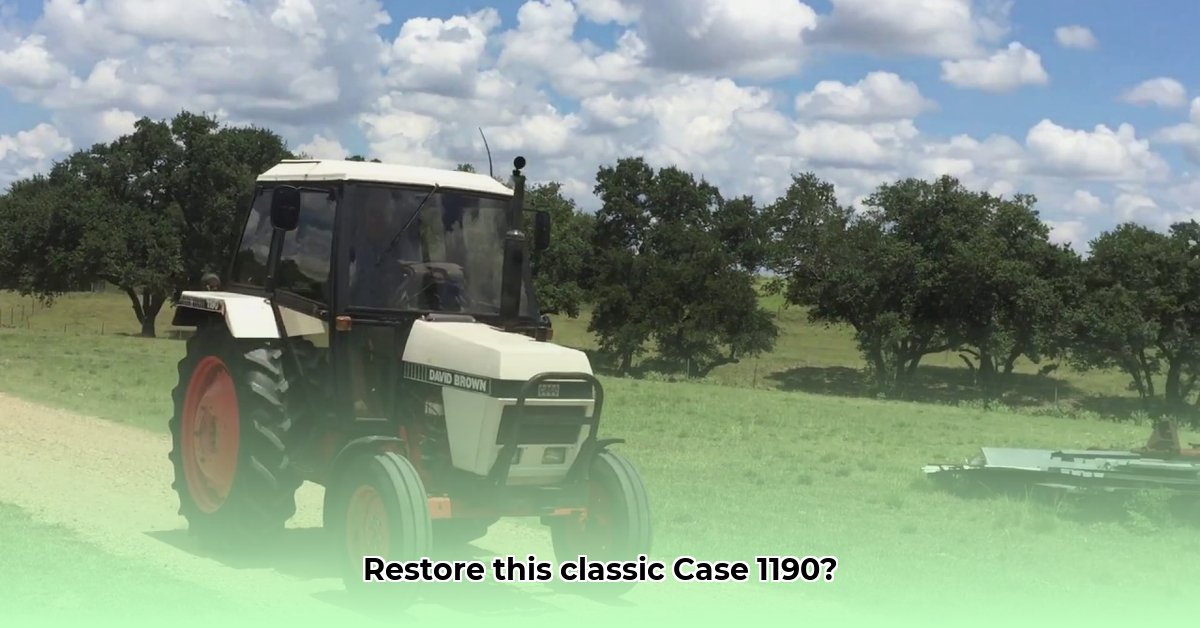
The Case 1190 tractor: a name synonymous with rugged dependability and classic agricultural engineering. This 1980s workhorse, born from the merger of J.I. Case and David Brown, offers a compelling blend of robust design and intriguing challenges for both restoration enthusiasts and practical farmers. This review and instructional guide provides a comprehensive overview, addressing both the machine's strengths and weaknesses, and offering actionable advice for potential buyers and restorers. For more information on Case tractors, check out this helpful resource: Case Tractor Info.
A Legacy Forged in the Fields: The Case 1190's History
The Case 1190’s origins lie in the powerful combination of J.I. Case and David Brown, two titans of agricultural machinery. This union resulted in a tractor with distinctive design features, reflecting the engineering philosophies of both parent companies. This heritage contributes to its robust build quality, but also presents unique challenges for parts sourcing and restoration. Finding replacement parts can require more detective work than straightforward online shopping. But does this legacy translate to sustained performance? Let's delve into the specifics.
Performance Analysis: Workhorse or Headache?
The Case 1190 boasts several impressive features. The live PTO (power take-off) and live hydraulics are frequently lauded by owners for their smooth operation and efficiency-boosting capabilities. Many long-time owners report remarkably long lifespans, with some machines accumulating thousands of hours on their original components – a true testament to its inherent durability. However, a significant drawback often mentioned is the transmission. Reports suggest a tendency for the transmission to pop out of reverse under heavy loads, a crucial factor to consider when evaluating the tractor's overall reliability.
Case 1190: A Detailed Feature Assessment
The following table summarizes the key features and their associated advantages and disadvantages:
| Feature | Pros | Cons |
|---|---|---|
| Transmission | Generally robust; high potential for longevity with proper care. | Prone to popping out of reverse under heavy loads; necessitates careful inspection. |
| PTO | Live PTO system enables smooth, uninterrupted operation; boosts efficiency. | No significant drawbacks reported. |
| Hydraulics | Live hydraulics enhance versatility and convenience across various tasks. | Straightforward system; may lack advanced features found in newer models. |
| Durability | Many owners report extraordinarily long operational lifespans. | Longevity heavily reliant on meticulous maintenance and prudent operation. |
| Parts Availability | Can prove challenging; thorough research and sourcing are often required. | Expect to invest time and effort in locating necessary components. |
Pre-Purchase Inspection: A Critical Checklist
Purchasing a used Case 1190 demands a meticulous pre-purchase inspection. Do not skip this vital step! Prioritize the following:
- Transmission Examination: This is paramount. Rigorously test the reverse gear under substantial load. Listen attentively for any unusual sounds (grinding, whining, or popping) that indicate potential transmission problems.
- Hydraulic System Check: Inspect all hydraulic lines and connections for leaks. Thoroughly test all hydraulic functions for smooth and efficient operation.
- Overall Condition Assessment: Conduct a comprehensive visual inspection for rust, wear, and tear. Carefully examine the engine compartment for leaks or indications of neglect.
- Professional Consultation: Whenever feasible, engage a qualified mechanic for a professional inspection. This can prevent costly surprises later.
Case 1190 Restoration: A Step-by-Step Guide
Restoring a classic tractor is a labor of love – a rewarding blend of mechanical skill, patience, and dedication. Follow this structured approach:
- Budgeting: Develop a meticulous budget, encompassing not only parts but also labor, tools, and potential unforeseen costs. Overestimating is always preferable to underestimating.
- Parts Sourcing: This can be demanding. Utilize online forums dedicated to classic Case tractors; these are invaluable resources for information and parts. Consider specialized parts suppliers as well.
- Prioritization of Repairs: Address critical repairs first – focusing on the transmission, engine, and hydraulic systems. Cosmetic restoration can follow once mechanical soundness is established.
- Seeking Professional Assistance: Don't hesitate to seek expert help from a qualified mechanic for complex repairs. This can save both time and money in the long run.
Maintaining Your Case 1190: Long-Term Care
Regular maintenance is crucial for maximizing your tractor's lifespan and preventing costly repairs. Consider it an investment protecting your investment.
- Fluid Changes: Adhere strictly to the manufacturer's recommended intervals for oil and filter changes.
- Routine Inspections: Regularly inspect all belts, hoses, and connections for wear and tear, addressing minor issues promptly.
- Preventative Maintenance Records: Maintain detailed records of all maintenance and repair tasks. This comprehensive history aids in anticipating future needs and effective budgeting.
Is the Case 1190 the Right Tractor for You?
The Case 1190 offers a unique blend of strengths and weaknesses. Its transmission presents potential challenges, but its durability and efficient hydraulic/PTO systems remain highly attractive. Carefully assess your mechanical aptitude, available resources, and risk tolerance before making a decision. With careful planning, diligent maintenance, and a touch of patience, this classic tractor can reward its owner with years of reliable service and a satisfying restoration experience.